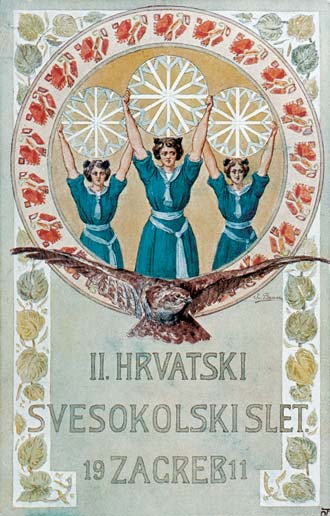Permanent Display 37. Life in Associations
 Following the example of Central Europe, in Zagreb, too, numerous associations were founded in the second half of the 19th century, a new way of living and communicating. As well as cultural, singing, labour, sports and entertainment associations, there were also societies that brought together educated people interested in science and art, and many voluntary charitable associations.
Following the example of Central Europe, in Zagreb, too, numerous associations were founded in the second half of the 19th century, a new way of living and communicating. As well as cultural, singing, labour, sports and entertainment associations, there were also societies that brought together educated people interested in science and art, and many voluntary charitable associations.
The singing associations are to be credited with the spreading of musical culture; they also disseminated Croatian national songs. The Zagreb singing society called Kolo (1862) was particularly distinguished in spreading patriotic feelings. Workers looking for jobs in the capital were among the first to organise themselves by founding their own labour and charitable and singing societies.
 The most attractive of all, though, was the physical exercise society called Hrvatski sokol (Croatian Hawk) (1874). Perhaps more than by the exercise, the people of Zagreb were attracted by the ceremonies and dances that the Sokols regularly and successfully organised. The Croatian Hawk had an important role in the organisation of physical training in elementary schools. At the same time, the Hrvatsko planinarsko društvo (Croatian mountaineering society) was founded (1874); it encouraged good fellowship and familiarity with the homeland through its patriotic excursions.
The most attractive of all, though, was the physical exercise society called Hrvatski sokol (Croatian Hawk) (1874). Perhaps more than by the exercise, the people of Zagreb were attracted by the ceremonies and dances that the Sokols regularly and successfully organised. The Croatian Hawk had an important role in the organisation of physical training in elementary schools. At the same time, the Hrvatsko planinarsko društvo (Croatian mountaineering society) was founded (1874); it encouraged good fellowship and familiarity with the homeland through its patriotic excursions.
Of the many associations, mention should be made of the Družba Braće Hrvatskog zmaja (1905), founded to look after the Croatian cultural heritage. The members of this society are to be credited with having founded the City Library and the City Museum.
In a class of its own was the humorous society called KVAK (1879) in which distinguished Zagreb people got together – writers, actors, painters, printers, traders – but only men, for ladies were allowed entry into the Pond only on New Year’s Eve.
At the beginning of the 20th century the need was felt to unite Zagreb’s many sports clubs; the biggest of them, the Croatian Academic Sports Club, lasted right down until 1945.
Many of the leading citizens were members of several societies. How vigorous social life in Zagreb was is best shown by the list of societies in 1894. There were at that time 78 registered associations with 57,115 members, and the little city of Zagreb had a population of hardly 30,000.
Željka Kolveshi

